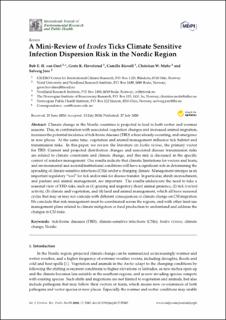| dc.description.abstract | Climate change in the Nordic countries is projected to lead to both wetter and warmer seasons. This, in combination with associated vegetation changes and increased animal migration, increases the potential incidence of tick-borne diseases (TBD) where already occurring, and emergence in new places. At the same time, vegetation and animal management influence tick habitat and transmission risks. In this paper, we review the literature on Ixodes ricinus, the primary vector for TBD. Current and projected distribution changes and associated disease transmission risks are related to climate constraints and climate change, and this risk is discussed in the specific context of reindeer management. Our results indicate that climatic limitations for vectors and hosts, and environmental and societal/institutional conditions will have a significant role in determining the spreading of climate-sensitive infections (CSIs) under a changing climate. Management emerges as an important regulatory “tool” for tick and/or risk for disease transfer. In particular, shrub encroachment, and pasture and animal management, are important. The results underscore the need to take a seasonal view of TBD risks, such as (1) grazing and migratory (host) animal presence, (2) tick (vector) activity, (3) climate and vegetation, and (4) land and animal management, which all have seasonal cycles that may or may not coincide with different consequences of climate change on CSI migration. We conclude that risk management must be coordinated across the regions, and with other land-use management plans related to climate mitigation or food production to understand and address the changes in CSI risks. | en_US |

